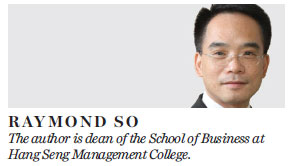The realities of boosting the city's tourism capacity
Updated: 2015-10-15 09:24
By Raymond So(HK Edition)
|
|||||||||
During the recent National Day Holidays, the number of visitors to Hong Kong increased compared with the same period last year. However, retailers did not benefit much from this. Many complained about falls in sales. This apparent disparity was initially puzzling. But with more details available, people realized that many visitors came to Hong Kong for specific reasons - like taking public examinations - rather than sightseeing and shopping. This shows that the number of visitors coming here and Hong Kong's ability to handle them remain poles apart. This has encouraged me to think more about ways to boost Hong Kong's capacity for handling more visitors.
In recent years, as the number of visitors to the city has increased substantially, the issue of Hong Kong's tourist-carrying capacity has generated different responses. There were those who argued that the city's capacity cannot meet the challenges brought about by a robust growth in tourist numbers. Because of this, some people have reacted negatively to the influx of tourists. However, Hong Kong is an open society and we cannot turn visitors away. So the only possible solution is to increase the city's overall capacity for handling tourists.
Indeed, many solutions suggested so far have centered on how to increase capacity. But this is not going to be easy. Achieving greater capacity requires considerable flexibility during the planning process. This is something which is hard to achieve when the city is still divided over some controversial issues.
If we want to boost our ability to cope with more tourists, we need to increase the capacity of every support industry. For example, if our public transport system is inadequate, we clearly need to boost its capacity. Yet, because of various constraints, this is much easier said than done.
Take the Mass Transit Railway (MTR) system. When the MTR was first built in the 1970s, there was no way project designers could have predicted the huge growth in passengers today. Some have suggested the problem of congestion could be solved by increasing the service frequency of trains. But they have ignored a basic fact: The service frequency is constrained by design capacity. The MTR Corporation should not be blamed for planning decisions made in the past. No one could have predicted the rapid development of Hong Kong over the past 30 to 40 years.
This leads to careful consideration of the issue of capacity planning for the future. The planning process covers many parameters. But no planners can accurately predict so many unknown factors. It could be a good practice to design and build any utility with excess capacity. This would leave room for future expansion.
However, this flexibility is not without costs. For example, in the argument for increasing the MTR's train frequency to ease congestion, it is assumed there is always excess capacity which can be exploited. That would mean the MTR would have to set aside resources for future expansion. But this will show up in costs. Who is going to pay these additional costs? The MTR is a public company, so the increase in costs will ultimately have to be compensated for by higher fares. This will obviously not be popular with the public.
For other services, if the costs of extra capacity are borne by the government then it can then be accused of inefficient use of public resources. In other words, the issue is about people wanting to have extra capacity for future expansion, but no one wanting to pay higher costs.
In tackling the problem, the most important point is the overall interests of society. If the city fails to properly handle its capacity for coping with tourists, other sectors could also suffer. We need to evaluate the issue holistically and consider current needs as well as future challenges. This will obviously lead to higher costs and require people to be prepared to accept them.

(HK Edition 10/15/2015 page8)